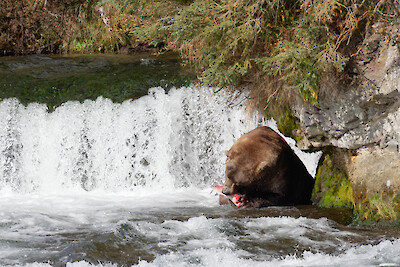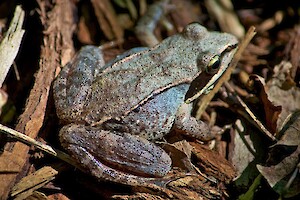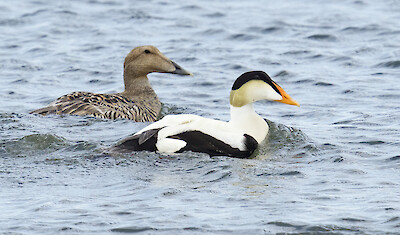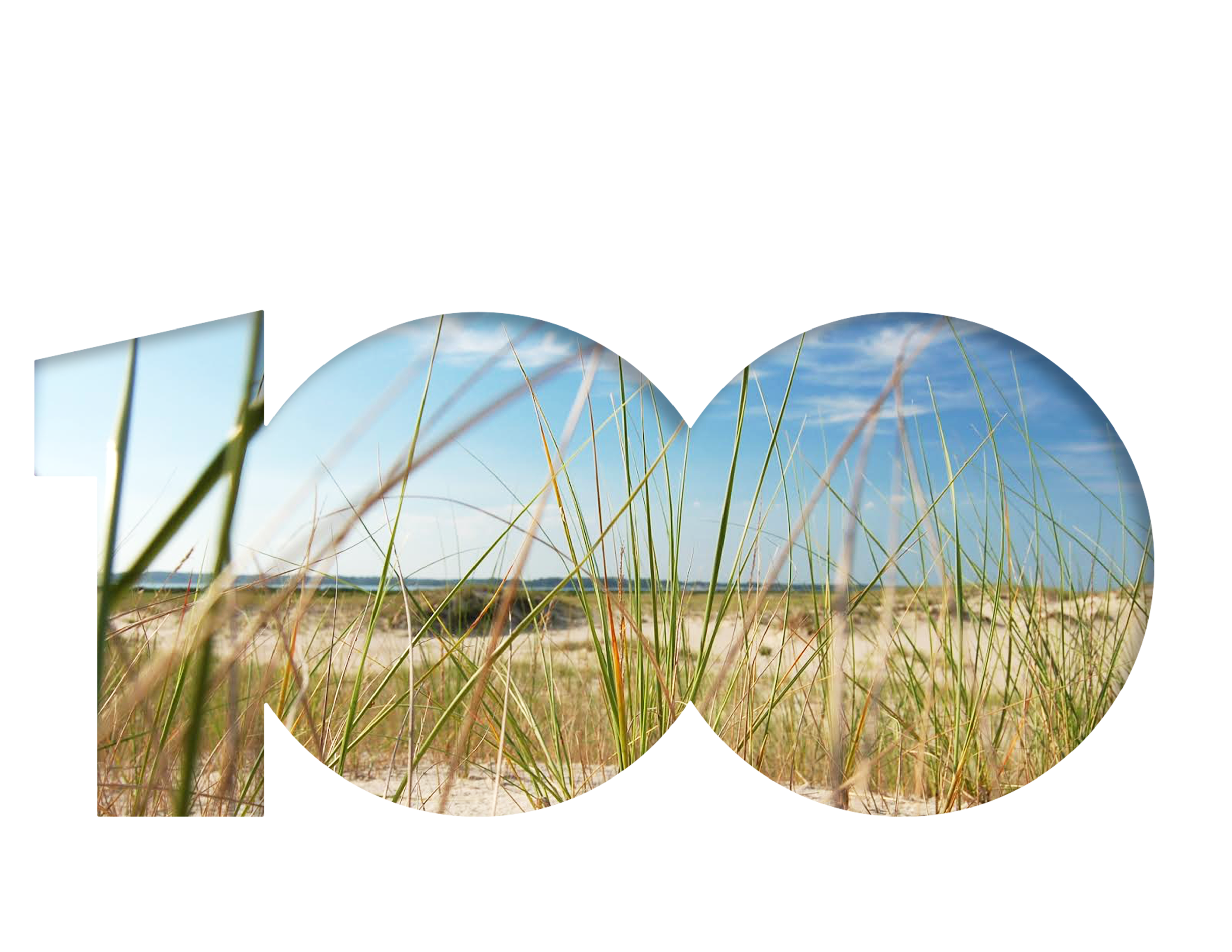The Bears are Fattening, the Frogs are Freezing
Sidney Anderson ·One of my favorite weeks of the year is “Fat Bear Week,” hosted by Katmai National Park. This is a March Madness-style bracket of, you guessed it, fat bears as they prepare for winter hibernation in Alaska. For the last 11 years, the National Park Service has promoted their popular brown bears in this week-long contest to crown the king or queen of the falls. If you haven’t checked out the Brooks Falls live stream, I’d highly recommend it. This livestream lets you follow your favorite bear, watch them hunt, interact with other bears, and generally go about their bear-shaped lives doing bear-shaped things. Loyal livestream watchers know certain bears by number and name, wait with bated breath for them to return to the falls, and come back every year to campaign for their champion. During Fat Bear Week, you can vote once per day for your favorite bear in each matchup, or the bear you think is best prepared for their long winter nap. This challenge is preceded by “chubby cubby” Fat Bear Junior, where the younger animals get a chance to shine in their first few years of winter preparation. Use this link to follow Fat Bear Week this year and vote for your favorite bear.

Okay, this has been fairly lighthearted so far, but let’s get serious. I love Fat Bear Week because I love bears, but I also love Fat Bear Week because it highlights one of the most interesting and difficult things an animal can do: hibernation. In fact, the different ways the animal kingdom survives extreme weather is the topic that fascinates me most as an ecologist. During my second year of college, I took a course called Winter Ecology; it was easily my favorite course of my entire education and, looking back, was probably the catalyst for my personal fascination with animal physiology and thermoregulation.
Let’s start with hibernation. We know it as the long winter nap that bears take from around November to March, but what does hibernation actually mean? Hibernation is a form of dormancy—when an animal slows its bodily processes down to survive a period of hardship. In order for this period to be true hibernation, three things must happen: reduced metabolism, reduced heart rate, and reduced body temperature. In other words, hibernation means slower energy processing, slower breathing, and lower body temperature. Hibernation is most commonly referenced as a way to save energy when food is scarce and maintaining body heat is difficult during winter months. Typically, this is a phenomenon seen in small mammals in cold climates, for whom foraging is time- and energy-consuming and comes with a high risk of predation. In an animal as large as a bear, the ability to adjust their metabolism is impressive, especially when you remember that female bears give birth during hibernation and must have prepared enough to get both herself and her cubs through the winter. However, because a bear’s body temperature does not drop as sharply as others’ do, and they remain relatively conscious, technically, it is not true hibernation.
True hibernators, like some rodents and bats, can reduce their body temperatures an impressive amount and enter a state of unconsciousness so deep it takes days to wake up. The Arctic ground squirrel can reduce its temperature to 27℉ (-3℃), about 70℉ lower than their usual body temperature. While the Arctic ground squirrel hibernates alone, other species like bats and marmots hibernate as family groups. For such small animals it is hard to maintain a high body temperature, so cooling down and staying in for the winter is a key survival strategy. The little brown bat is the smallest known hibernator, weighing in at only 5 grams; they wait out the winter in tree cavities and abandoned buildings.

For organisms that don’t generate their own body heat, like reptiles, amphibians, and insects, winter poses a different set of challenges. Many reptiles and amphibians rely on behaviors to manage their body temperatures—like moving back and forth from sun to shade—but what do they do when those warm places aren’t so warm? Many enter a period called brumation, a type of dormancy similar to hibernation; though they cannot digest food, they must continue drinking water throughout the winter. Some snakes make use of natural holes or cavities, called a hibernaculum, to huddle up and wait out the cold weather. Some amphibians and most insects use one of two other options, embracing the cold (freeze avoidance) or freezing solid (freeze tolerance). Freeze avoidance means lowering the freezing temperature of the body’s fluids. They accomplish this by increasing antifreeze proteins in their blood, the same way we put antifreeze in our cars to keep the engine working. These antifreeze proteins and fewer particles for ice to form around prevent freezing and increase survival. On the other end of the spectrum, the wood frog burrows down into the leaf litter and turns itself into a frog-sicle. They also use internal antifreeze to prevent damage inside their cells, but allow the space between the cells to freeze. This, combined with effectively stopping breathing and heartbeats, allows them to wait out the winter and thaw as soon as spring temperatures are warm enough. This freeze tolerance is being studied for use in the medical world to improve human tissue preservation.

While a large number of bird species migrate to warmer climates for the winter, many stay in places that experience severe cold. Those that remain in colder areas rely on their feathers to provide effective insulation; there’s a reason down coats are so popular among humans. The air trapped between their down feathers warms from their body heat, and the outer layer of feathers keeps that warm air in place. Birds also have adaptive behaviors, such as choosing perches protected from wind or puffing up their feathers to make that warm layer even thicker. Species like hummingbirds, swifts, and nightjars experience another type of dormancy, called torpor, where they drastically slow their metabolism and let their body temperature drop; however, birds usually only use this method for a few hours at a time, not long term like other animals we’ve discussed. Smaller birds, like golden-crowned kinglets, have been observed huddling in tree branches overnight to preserve warmth. The down of the common eider is widely accepted as the most insulative down of any species due to the puffy nature of the feather and the ability of these feathers to interlock, preventing them from blowing apart during an arctic wind. This bird lines their nest with down feathers plucked from the mother’s body, keeping the chicks nice and warm while they grow. Unfortunately, the warmth of this down makes these birds a target for hunters for its use in human fashion. As a result, there are some protections in place to prevent overhunting of the species. Eiderdown farmers use a sustainable collection system, providing nesting area to the birds during the reproductive season and then collecting the down used to line the nest once the nest is empty. I highly recommend the movie Birds of Feather, which chronicles the relationship between the Inuit community on Hudson Bay in Canada and the eider duck.
No matter your size and shape, enduring winter is difficult. From Alaska’s brown bears to frozen frogs in the forest, different species display a wide variety of adaptations to survive the winter. Every year, we learn more and more about how animals survive extreme conditions, each more fascinating than the last. This year, as we (fingers crossed) play in the snow and drink our hot chocolate, don’t forget about all the amazing things going on outside. Winter may seem quieter, but it certainly is no less exciting, if only because we know the fat bears are well-prepared for their naps.
About the author
Sidney Anderson

Sidney Anderson earned her MSc from Georgia Southern University and her BA from College of the Atlantic. She has researched the thermal biology of the Florida scrub lizard and modelled their potential responses to climate change, as well as studied the reproductive biology of yellow-spotted salamanders and painted turtles in Acadia National Park. She is originally from New Jersey and enjoys camping, birding, playing soccer, fencing, and making art.

